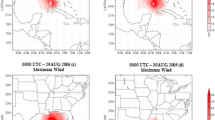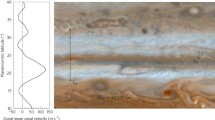Summary
Dissipative heating has not been accounted for in either numerical simulations of hurricanes or in theories for the maximum intensity of hurricanes. We argue that the bulk of dissipative heating occurs in the atmospheric boundary layer near the radius of maximum winds and, using both theory and numerical simulation, show that dissipative heating increases maximum wind speeds in tropical cyclones by about 20%.
Similar content being viewed by others
References
Bister, M. 1996:Development of Tropical Cyclones from Mesoscale Convective Systems. Ph.D. thesis, Mass. Inst. Tech., 112 pp.
DeMaria, M., Kaplan, J., 1994: A statistical hurricane prediction scheme (SHIPS) for the Atlantic basin.Wea. Forecasting,9, 209–220.
Elsberry, R. L., Emanuel, K. A., Holland, G., Gerrish, H., DeMaria, M., Guard, C., 1992: Is there any hope for tropical cyclone intensity prediction? A panel discussion.Bull. Amer. Meteor. Soc.,73, 264–275.
Emanuel, K. A., 1986: An air-sea interaction theory for tropical cyclones. Part I.J. Atmos. Sci.,42, 1062–1071.
Emanuel, K. A., 1988: The maximum intensity of hurricanes.J. Atmos. Sci.,45, 1143–1155.
Emanuel, K. A., 1995a: Sensitivity of tropical cyclones to surface exchange coefficients and a revised steady-state model incorporating eye dynamics.J. Atmos. Sci.,52, 3969–3976.
Emanuel, K. A., 1995b: The behavior of a simple hurricane model using a convective scheme based on subcloud-layer entropy equilibrium.J. Atmos. Sci.,52, 3959–3968.
Emanuel, K. A., 1997: Some aspects of hurricane inner-core dynamics and energetics.J. Atmos. Sci.,54, 1015–1026.
Holland, G. J., 1997: The maximum potential intensity of tropical cyclones.J. Atmos. Sci. 54, 2519–2541.
Miller B. I., 1958: On the maximum intensity of hurricanes.J. Meteor.,15, 184–195.
Rotunno, R., Emanuel, K. A., 1987: An air-sea interaction theory for tropical cyclones. Part II.J. Atmos. Sci.,44, 542–561.
Schade, L. R., 1994:The Ocean's Effect on Hurricane Intensity. Ph.D. Thesis, Mass. Inst. Tech., Cambridge, MA. 127 pp.
Author information
Authors and Affiliations
Additional information
With 4 Figures
Rights and permissions
About this article
Cite this article
Bister, M., Emanuel, K.A. Dissipative heating and hurricane intensity. Meteorl. Atmos. Phys. 65, 233–240 (1998). https://doi.org/10.1007/BF01030791
Received:
Revised:
Issue Date:
DOI: https://doi.org/10.1007/BF01030791




